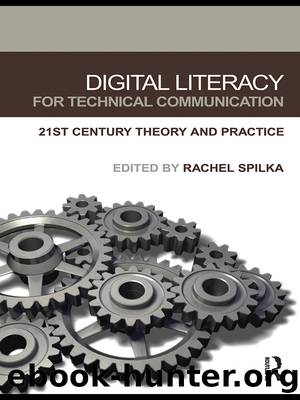Digital Literacy for Technical Communication by Spilka Rachel;

Author:Spilka, Rachel;
Language: eng
Format: epub
Tags: Humanities
Publisher: Taylor & Francis Group
Published: 2009-11-09T00:00:00+00:00
Of course SGML and its now more familiar markup progeny, HTML and XML, are just tools. Goldfarb, of course, is referring instead to the set of practices that SGML, HTML, and the World Wide Web have enabled and that forms what he calls the âinfrastructure of modern society.â I find it useful to call these practices, taken together, âcontent management.â
To our credit, the field of technical communication has had an eye on these practices for some time, well before they became the coherent software-based CM systems that we know today. In the late 1980s and early 1990s, groundbreaking contributions by scholars (such as Sullivan, 1989; Schriver, 1993; Bernhardt, 1993; and Redish, 1993, among others) expanded the scope of technical communication work as the field contemplated the future of electronic documents. We recognize this group of writers, in particular, as pioneers who helped us imagine how our fieldâs care in thinking about issues of audience translated, in the digital era, to thinking about usability. This work created the space for a more specific set of conversations to emerge focusing on the core ideas of CM. Weiss (1993) questioned the way document databases and markup languages were shifting the balance of power to the reader/user and away from the writer. Bist (1994; 1996) and Price (1997) offered early conceptual frameworks for CM practice, pointing to the potentialities that languages like SGML offered, but focusing more on the conceptual and strategic differences associated with authorship and with texts as artifacts. Both Bist and Price anchored their discussions of CM in the practices of object-oriented modeling associated, at the time, exclusively with computer programming. Heba (1997) clearly framed the conceptual shifts implied by an object-oriented approach to writing. He argued that technical communicators need to understand that they are creating user environments rather than static texts, that these environmentsâ core structure is modular rather than hierarchical, and that a âdocumentâ can be a combination of complete elements but, due to its ability to adapt and change as usersâ needs change, may never be complete (p. 281).
Hebaâs perspective was shaped by another conversation about hypertext that had been going on in technical communication and the allied field of computers and writing. Before the advent of the World Wide Web, a group of scholars explored the implications of texts that included dynamic links and embedded multimedia elements for technical communication (Mehlenbacher, 1993; Selber, et al., 1996). The conversations about hypertext by Johnson-Eilola (1996), Selber, and others were interdisciplinary, ranging across literary theory (Landow, 1992), information science, and computer engineering (Nelson, 1964; 1974; Nielsen, 1990), and stretching back, famously, to Bushâs 1945 Atlantic Monthly article âAs We May Think.â Bushâs article, known for its description of a mechanical hypertext prototype machine called a memex was more accurately a call to develop CM processes. We have, for the most part, fulfilled Bushâs 1945 vision today, though our capacity to create information has grown in ways that make the impressive gains in managing it seem just as inadequate as
Download
This site does not store any files on its server. We only index and link to content provided by other sites. Please contact the content providers to delete copyright contents if any and email us, we'll remove relevant links or contents immediately.
Index to the London Magazine by Frank P. Riga Claude A. Prance(187)
Female Impersonation by Carol-Anne Tyler(131)
Creativity and Feature Writing by Ellie Levenson(120)
A Filtered Life by Nicole Taylor Mimi Nichter(115)
Xenolinguistics; Towards a Science of Extraterrestrial Language by Douglas A. Vakoch & Jeffrey Punske(114)
Theories of Journalism in a Digital Age by Steen Steensen Laura Ahva(110)
Critical Communication Pedagogy by Fassett Deanna L.;Warren John T.; & John T. warren(108)
Torture, Intelligence and Sousveillance in the War on Terror by Vian Bakir(105)
Origin Of Ethnography In Japan by Minoru Kawada(100)
Developing Translanguaging Repertoires in Critical Teacher Education by Zhongfeng Tian Nicole King(100)
Computing the News: Data Journalism and the Search for Objectivity by Sylvain Parasie(98)
Transformative Media Pedagogies by Paul Mihailidis Sangita Shresthova Megan Fromm(96)
Peace Journalism in East Africa by Fredrick Ogenga(94)
Matter Transmission by Nicolás Salazar Sutil(91)
Media Audiences by Sue Turnbull(88)
A Networked Self and Platforms, Stories, Connections by Zizi Papacharissi(87)
Revisiting Transnational Broadcasting by Nelson Ribeiro Stephanie Seul(86)
Media Studies 2.0 by William Merrin(85)
The Gentrification of the Internet by Jessa Lingel(85)
